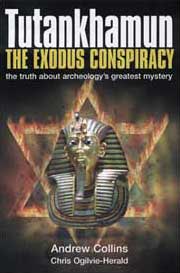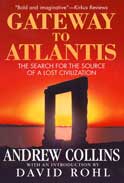
for
a wide selection of books that challenge orthodox views of prehistory
on every continent
![]()

text translation service for 25 worldwide languages
book reviews
“Tutankhamun
– The Exodus Conspiracy”
–
the Truth Behind Archaeology’s Greatest Mystery –
by
Andrew Collins & Chris Ogilvie-Herald
you can order this title directly from
by clicking on the book cover
you can order this title directly from
Amazon.co.uk by clicking on the UK edition link

UK edition
“The
discovery of Tutankhamun’s tomb, in early November 1922, is considered
the singular most important arch?ological find of the modern era. The
intact burial chamber promised to reveal lost knowledge of one of the
most enigmatic and intriguing civilizations known to man. However, as
much myth and mystery shrouded its disclosure, as potential secrets of
the Egyptians unearthed.
Collins and Ogilvie-Herald attempt to disentangle the web of deceit, politics,
and petty jealousies, and in doing so lead one into the world of Moses
and the Exodus, shining fresh light on the origins of the Israelite race,
with profound ramifications for the current Middle East conflict. They
do this by combining a well researched, thoughtfully argued, and authoritative
approach, with a convincing and easy style and exciting sense of discovery.
Tutankhamun lived during an unusual and interesting episode of Egyptian history. As well as being Akhenaten’s son and son-in-law, he was reputed to be his full- or half-brother! Akhenaten inspired the Amarna heresy. By adopting a monotheistic belief system, based on Aten, an ‘omnipotent bisexual force symbolised by the light and heat of the sun’s rays’ whilst deprecating the traditional polytheism of the Theban god Amun-re. He relocated the cultural capital to Heliopolis, where the high priests were then based. At this time, in the mid 14th century BC, Egypt faced a plague. The masses were unsettled, believing they had incurred the wrath of their forefather’s gods, and when Tutankhamun came to reign, he reverted to the old religion. At the same time he changed his name from Tutankhaten, thus severing his links with his predecessor’s cult.
Manetho, an Egyptian scribe from the 3rd century BC, related how the Jews were descended from lepers and impure Egyptian priests of the ‘old religion’. This is somewhat at variance with events as described in the Pentateuch, however, the Pentateuch was not committed to writing until the 7th century BC. It would therefore seem necessary to piece together as many fragments as possible in order to unweave the truth from the biases of the people and cultures who related these histories.
Nearby, in trans-Jordan, lived the Shasu tribes, who were nomadic pastoralists, and the original Yahweh worshippers. Further north, were the Habiru or Apiru, mercenary Semitic peoples, who terrorized the Canaanite city states, including vassals of Egypt, and from whom a derogatory term Hebrew may have arisen.
Israel was probably a dominant Shasu clan. Shasu territories would have encompassed ancient Petra, which was later developed further by the Nabateans. Close to Petra is the mountain of Jebel al-Madhbah. On its summit is carved an altar, which is associated with moon worship, particularly at the equinoxes, and is aligned to Jebel Har?n. Its layout has a remarkable similarity to that of Solomon’s Temple, and associations with the Feast of Passover cannot be ignored. The authors conclude this is where Moses received the Ten Commandments, and surmise that Jebel Har?n was where the scapegoat ritual was enacted, which corresponds to Mount Hor and Mount Seir.
Collins and Herald-Ogilvie also conclude that pork abstinence was derived from the Nile Delta at the time of the Exodus, and was upheld and spread by the people who migrated from this region. They therefore believe that the ‘Mosaic religion’ was a ‘fusion of ideas and beliefs from peoples of different cultures and backgrounds’, i.e. in particular Aten and the mountain god Yahweh.
According to the Bible, the conquest of Canaan by the Israelites occurred when they formed two groups in order to split the attack from the north and the coast and south. At this time, the sun is said to have stood still in the sky for a whole day – was this a cometary reference? However, there is little hard arch?ological evidence for such an event, and Alt & Noth, and Mendenhall have presented alternative scenarios. Alt & Noth proposed a peaceful infiltration model, whereby the Canaanites and Israelites coexisted initially, but developed disputes over land and water rights, leading to a conquest. Mendenhall suggested that the Israelites in the surrounding area took the lands by a peasants’ revolt. Whatever the case, the Israelites continued to control the region until the conquest of the Jews by the Roman Emperor Titus in AD70, and then lived in exile for the next 1800 years, until 1917.
Zionism really begun when Herzl published his book Der Judenstaat, in 1896, in which he outlined his visions of a future Jewish State in Palestine, whereby rich Jews would fund the settlement of poor repressed Jews, particularly of Russia and Eastern Europe.
British interests in Jewish resettlement stem from fundamental Christian beliefs, and culminated in the Balfour Declaration in 1917, which stated:
“His Majesty’s Government view with favour the establishment in Palestine of a national home for the Jewish people, and will use their best endeavours to facilitate the achievement of this object, it being understood that nothing shall be done which may prejudice the civil and religious rights of existing non-Jewish communities in Palestine, or the rights and political status enjoyed by Jews in any other country.”
The British agreements for resettlement appear to have been the driving force behind the United States entry into World War One on the British side, as it was the Zionist Jews in America who influenced and supported the change in official and public opinion.
|
|
When Tutankhamun’s tomb was discovered by Howard Carter, Lord Carnarvon, Pecky Callender, and Lady Evelyn Herbert, it seems they could hardly contain their excitement, and entered it without permission through a small hole, later attributed to tomb robbers in the past. This was not their only transgression, which may have been exacerbated by altercations with the bumbling authorities. There is plenty of evidence to suggest they removed artifacts from the tomb for mostly personal gain, and these were distributed to family, friends, and overseas buyers. |
After Carnarvon’s death, for which there is evidence he was poisoned by mercury, Carter’s license was revoked. He met with a British official to seek a solution. This, however, became heated, and Carter threatened to reveal the contents of papyri found within the tomb, detailing the true account of the Exodus of the Israelites from Egypt. The official was reputed to have launched an inkwell which narrowly missed Carter. However, the threat did not materialize, and an ‘adjustment’ was made which appeased the situation.
There appears to be enough evidence to support the existence of such papyri, but there whereabouts remain unknown. Is it possible they contained information from which Manetho’s, and Lysimachos’s accounts were derived? Any such revelations would have seriously derailed commitments made by the British to the establishment of a Jewish State within Palestine.
Lord Carnarvon was married to Almina Wombwell, the illegitimate daughter of Alfred Rothschild, and important member of the House of Rothschild, ‘the wealthiest and most powerful Jewish family in Europe’. It was from Rothschild that Carnarvon received much of his funds, and in turn used some of this to sponsor Carter. Did Carnarvon, who had mentioned a find of papyri in the tomb in letters, know too much?
Whatever the true course of events, this book certainly lives up to its reputation to ‘challenge the orthodox views on the timeframe and route of the biblical Exodus,’ and ‘the origins of the Israelite race and the foundations of the worship of Yahweh’. They also ‘look too at the evidence for the site of the Mountain of God, or Mount Sinai, and Israel’s conquest of Canaan – all of which will seriously bring into doubt traditional held beliefs concerning the origins of Jewish religion and Israel’s divine right to inherit Palestine, the land of its deliverance.’. In doing so, the authors ‘demonstrate that Carter and Carnarvon really did suppress documents found in the tomb of Tutankhamun which, if allowed to reach public domain, might well have changed the face of the Middle East for ever.’
For this, it is very highly recommended for any students of Middle Eastern history and current affairs, as well as those with an interest in Egyptology. As for the portents of the cracking of the sarcophagus lid at the time of Tutankhamun’s burial, and the predation of Carter’s canary by a cobra, a symbol of sovereignty worn by the pharaoh and very rarely encountered in the Valley of the Kings, I’ll leave for the readers to decide.”
reviewed by Naveed
Bhatti – Morien Institute –
other books by
Andrew Collins
and
Chris Ogilvie-Herald
include:
|
“Gateway to Atlantis”
UK Edition |
“Giza: The Truth”
UK edition |
ANDREW COLLINS in association
with NEXUS present:
CONFERENCE 2002”
ALTERNATIVE HISTORY, FORBIDDEN ARCHAEOLOGY
Sat 16 Nov – 9.30 am – 7.30 pm
Kennedy Hall, Cecil Sharp House,
2 Regents Park Road, LONDON NW1
(opposite London Zoo, 5 minutes from Camden Tube Station)
Andrew Collins and Chris Ogilvie-Herald will both be speaking at this event
please
take a look at our Ancient Mysteries Bookshoppe
for a wide selection of books
that challenge orthodox views of prehistory on every continent
your
purchases will help to support the building of our
Mysteries Archive
| skywatching | news &
new discoveries | marketspace | contact
![]() us
us
expeditions, conferences, workshops & study-tours
all
material on this page
morien institute
1996-2003

